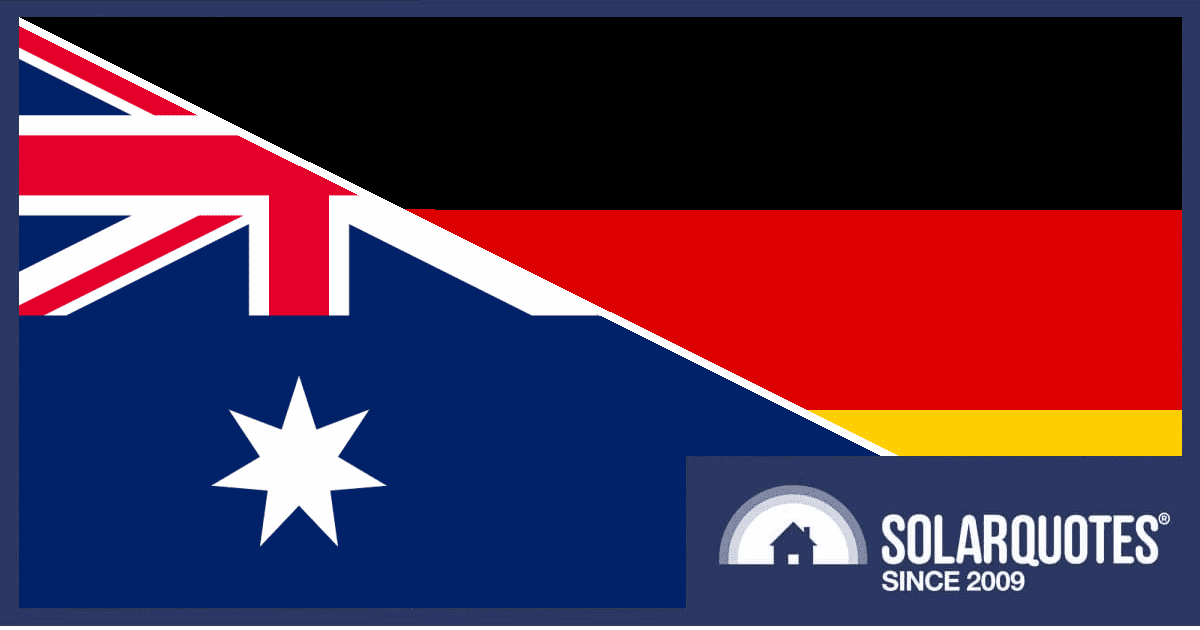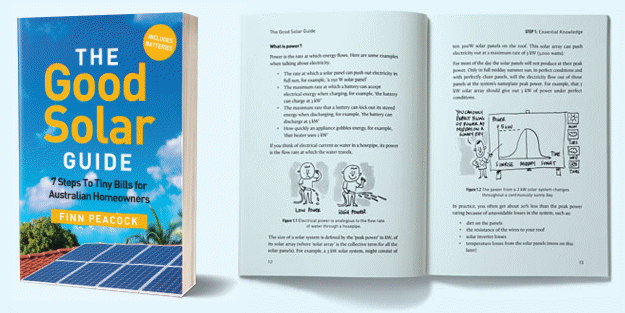
Solar energy covered around 14 percent of electricity consumption in Germany last year, up from 12 percent in 2023. How does that compare to Australia?
According to the Bundesverband Solarwirtschaft1, the total output capacity of all solar power plants, large and small, exceeded 100 gigawatts (GW) when the calendar flipped over to 2025.
Given Germany isn’t as sunny as Australia, PV meeting 14 percent of electricity consumption in 2024 is pretty impressive. Last week, we reported that for the full year of 2024, rooftop solar in Australia’s NEM2 accounted 12% of mains grid consumption. But what about with utility scale solar thrown in? According to Open Electricity, utility PV accounted for 7.1% of consumption last year – so the two together come to just over 19%.
BSW says “ground-level solar parks” (solar farms) were the biggest driver of PV growth in Germany, with a year-on-year increase of around 40 percent (6.3 GW – 32GW cumulative total). For rooftop commercial solar, it expects a growth increase of around 25 percent to 3.6GW (29GW cumulative total) last year.
But after several record years in a row, growth in home solar power system installations slowed in Germany. Compared to 2023, newly installed resident photovoltaic capacity (systems <30kW) fell by around an estimated 15 percent to 6.7 GW; bringing the total capacity installed to 38GW.
Overall, more than one million new solar power systems were registered in Germany in 2024, and installed photovoltaic capacity grew by around 10 percent compared to 2023.
As for Australia’s final figures for 2024, it’s still a bit soon to put a number on it.
Balcony Solar A Big Hit In Germany
Another aspect of PV that has been growing in Germany are “balcony” solar installations. These are small systems (maximum 800W capacity) feeding electricity directly into a power outlet to offset energy consumption within the home or building.
They’ve proven particularly popular in Germany, with newly installed capacity doubling in 2024 compared to the previous year (0.4 GW – cumulative total 0.7GW). If all those new systems were 800W (and they likely wouldn’t be), that works out to 375,000 installations in 2024.
What About Balcony Solar In Australia?
The total installed capacity of approved balcony solar installations in Australia is 0kW.
Balcony solar appears a decent idea for households without control of their rooftop, for example, apartment dwellers. So, given it *seems* like a no-brainer solution; why hasn’t it taken off here?
We don’t see these systems (legally) in Australia as back-feeding electricity into an electrical system creates several concerns. As an aside, such systems are pretty limited in what they’ll produce here. For a more in-depth look at these issues, Kim’s article on balcony solar systems from last year has some good info and interesting discussion following it.
Germany Vs. Australia’s Renewable Energy Targets
Germany has set at target for solar PV of 215 GW in 2030 – so, it has 5 years left to install another 100GW of capacity. It also has a target of 80 per cent of the country’s electricity sourced from renewables by the same year. According to Fraunhofer ISE, renewable energy’s share was 56 percent in 2024, compared to 55.3 percent in 2023.
The Australian Government has set a target of 82% renewable electricity nationally by 2030. In 2024, renewables accounted for 38.9% in the NEM and 38.8% in WA’s SWIS.
Footnotes
- BSW to its friends – aka German Solar Industry Association. ↩
- The National Electricity Market (NEM) is made up of Queensland, New South Wales (including the ACT), Victoria, Tasmania and South Australia. In Western Australia’s South West Interconnected System (SWIS), WA’s main electricity network, rooftop solar contributed approximately 26% of SWIS consumption in 2024. ↩

 RSS - Posts
RSS - Posts



On “balcony solar”. In 2004 I created a 12 v “balcony” system which, rather than attempting to plug into the domestic circuit, I used a stand alone 240 v inverter (600w) , as well as 3 camping freezers (12v/24v/240v AC). Last year I replaced the old FLA 12 volt batteries with Lithiums recycled from an old electric maxi scooter, and upgraded 12 volt solar panels, under an MPPT controller. Operating on 240 v AC, the freezers draw 150 w total, but can now run overnight @12 v, and my house can go completely off-grid and have all storage, (24 volt SLA batteries with a Selectronic inverter/ charger for my rooftop) back at full strength before midday. Be interesting to see how it goes in winter. The hot summer has really chewed up the rooftop solar keeping the house cool.
I wonder if anyone can measure what is happening behind the meter instead of just what the networks see – with low FIT, how much self-consumption is going on and are we really measuring the right things?
The OpenElectricity website mentioned in the article includes rooftop solar that is both exported to the grid and also self consumed.
The AEMO dashboard on their website doesn’t include rooftop solar self-consumption so is less useful..
I doubt that that the rooftop solar figure includes self-consumed energy. My 6 year old Fronius inverter isn’t communicating with my smart meter to report what’s generated. To get that data, I had to have my own little meter installed as part of the installation, which I can then read from the inverter.
All of this is coming though.
Germany now is at about 65% RE compared to our 40 -50%. The following happed recently: During a prolonged “dunkelflaute” – no sun, no wind in Germany, they imported lots of energy from Scandinavia and doing so exported inflation to Scandinavia due to higher power prices there.
The Swedish energy minister with name Busch complained that as Germany decided to become nuclear free or baseload free, it did not have the baseload nor the Russian gas to get over the energy shortage.
One solution to this problem was the suggestion not to renew the submarine cables to the EU, which are due for replacement or to close them.
As we no longer have the local gas and are talking of building import terminals (!), we are in the same bed as Germany as our 20GW of coal is disappearing in 2038 and we need to have 16GW of gas running by then.
From; Tony Enright
Having worked in coal/gas fired generation for >50 years, I have become very concerned about future generation, considering the complete failure of successive governments (state and federal) to take responsibility after cashing in on the privatisation of government assets constructed from mid sixties to early nineties
Regarding the need for life extension of coal fired stations, it is unlikely that any will make 2038, as they have reluctant owners with who would prefer to be paid (by government) to shut down, rather than risk the displeasure of their shareholders. Surviving stations should be acquired by Fed Gov, to ensure their continued service.
Regarding gas, it would be criminal to consign our future to a dependance on imported gas rather than develop our own supplies. On gas generation, eastern states have less than 10 gigs, and no visible appetite to build more.
Neither major party is offering a plan that will work – I have been writing to politicians for years, with little response. The ongoing confusion created by having both state and federal governments responsible for the provision of energy in Australia will ensure that pollies always have somewhere to hide.
Sorry to be so pessimistic, but having been involved in the greatest power station building boom in Australian history, I greatly resent its destruction by political ignorance and indifference
Best Regards
Hi Tony,
I really appreciate your insight but don’t share your pessimism, other than the privatisation issue, everyone knows that’s been treasonous.
(Now please excuse me while I deploy a canned response usually reserved for the less informed and less civil comments section)
“Baseload” is electricity jargon which used to mean the minimum load you could justify running a steam engine.
Now it’s been hijacked by the coal industry, it roughly translates to “please remember when we were kings”
Things like off peak water heaters were introduced so that large thermal plants could be kept ticking along at a base rate. Stoking them up and down every day shortens the life of a boiler, so artificially cheap tariffs were introduced to -create- demand where it would otherwise never be.
Instead of shaping demand with limited availability tariffs designed to suit lumbering inefficient thermal generators, we now have real time pricing to incentivise use when energy is cheap… so SAPN has for years offered a “solar sponge” tariff at 25% normal rates compared to 125% for peak use.
There is genuine surplus in the system so the cheap rates are in the middle of the day now, and they’re cheaper than ever. So much so that feed in tariffs for consumers have fallen to almost zero.
That means people have incentive to change their behaviour, use their own energy, be more efficient. It’s actually well suited to large thermal batteries like hot water and ceramic heat banks.
Combined with demand response, where you’re effectively paid to curtail your use, and dynamic tariffs to incentivise batteries, “baseload” just disappears in a puff of smoke called negawatts.
https://jeromeaparis.substack.com/p/the-real-lesson-about-the-end-of?fbclid=IwAR2SLUYvlNVRNPeXlpHQuMv8hxrioJHXjuJAiljidvCr9218axMyESh0xd8
The linked article states that the share is 62%.
The 62.7 percent refers to net public electricity generation from renewable energy sources. According to Frauhofer:
“The share of renewable energy generated in Germany in the load, i.e. the electricity mix that comes out of the socket, was 56 percent compared to 55.3 percent in 2023.”
An interest article. However, it is interesting comparing the change in 2023 and 2024 generation over the NEM in GWh (and percentage change):
Coal(+1.75%) and Gas(+14.5%) increased by 3528GWh, solar(11.58%) and wind (2%) by 4951GWh.
The disappointing aspect is CO2 emissions increased 2.28% as NEM total power increased by 3.45%.
That 82% RE goal in 5 years mentioned seems impossible:
*Data centres alone will increase requirements by 8 to 15% over the 5 years, not to mention EV requirements.
*Four Wind farms were cancelled last year- Kingston Offshore, Barney’s Reef, Doughboy and WA Offshore.
*We are already curtailing a significant portion of our Solar production, hopefully Snowy2 175GWh will solve some of this, but curtailment will probably increase..
increase as more solar is produced.